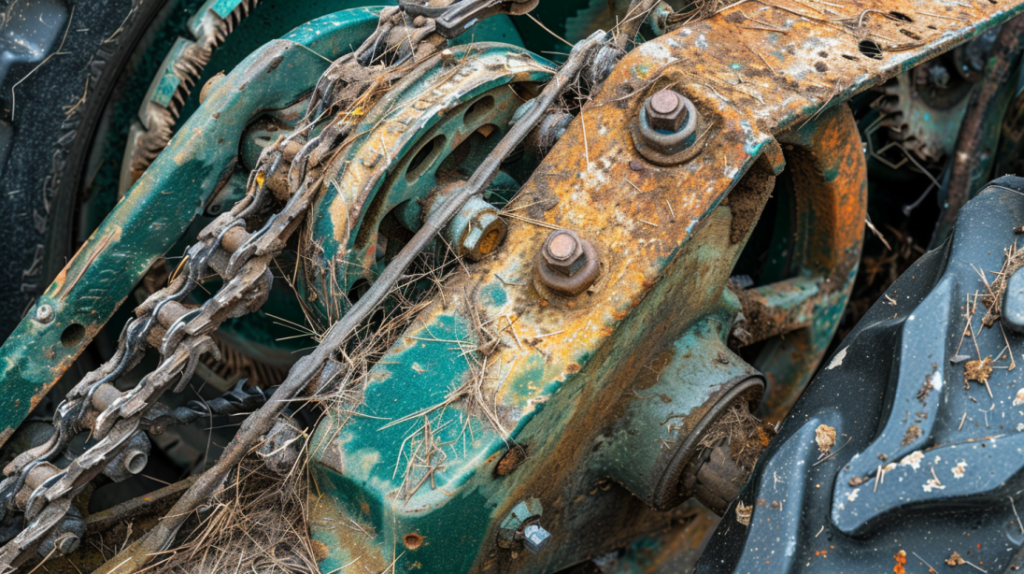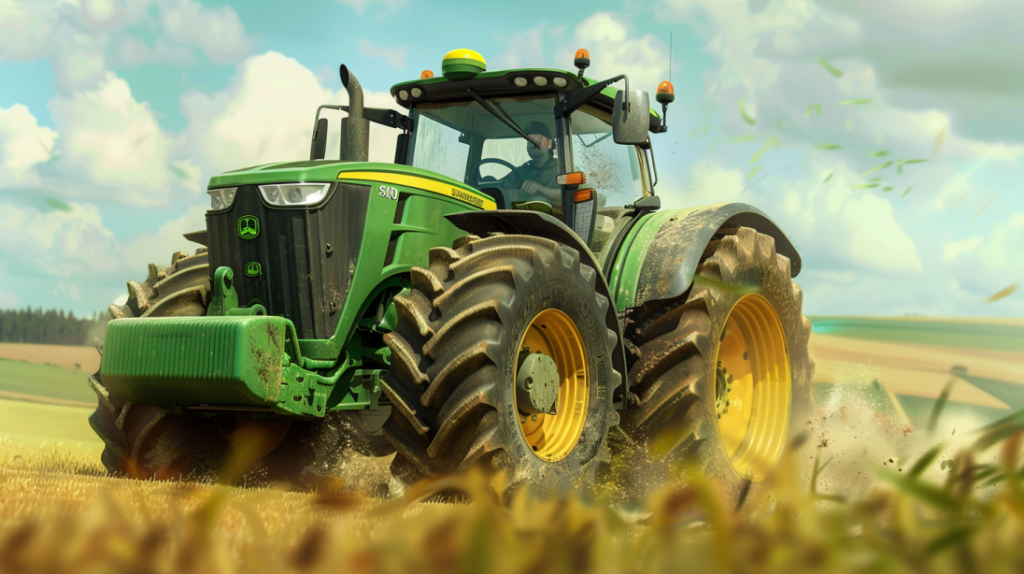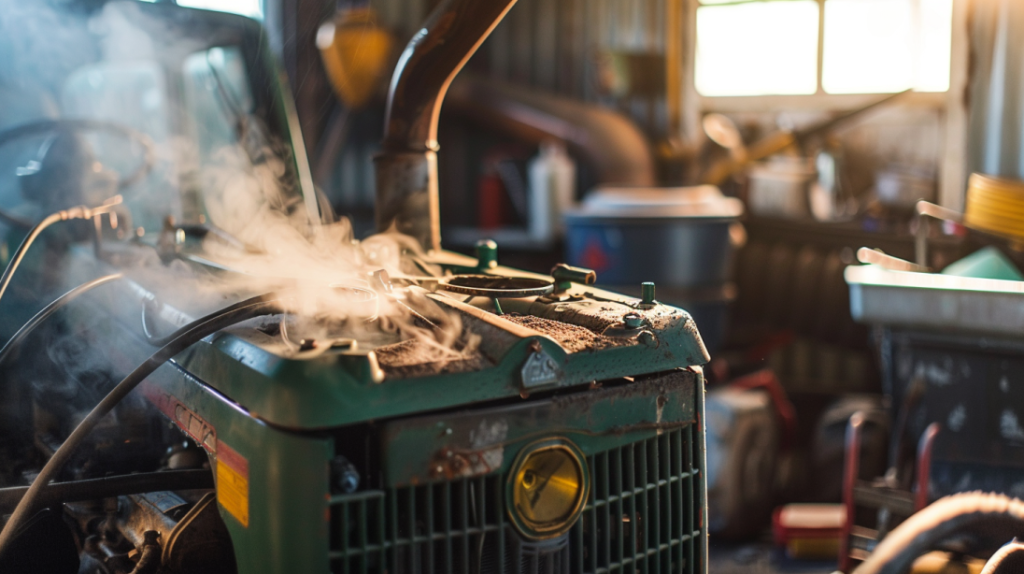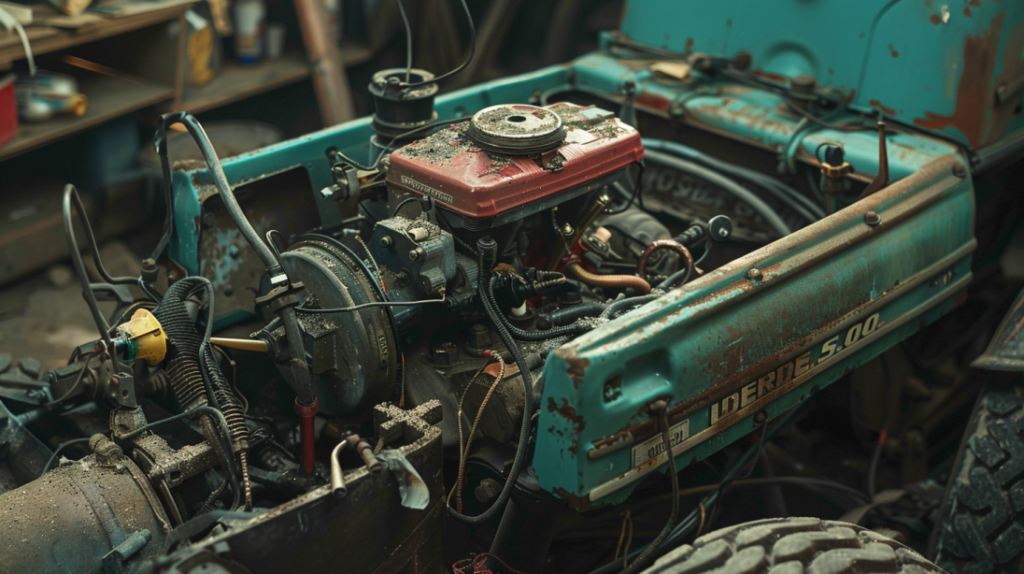If your John Deere S100 is giving you trouble, start by checking blade alignment and sharpness for a smooth cut. Engine stalling may indicate clogged air or fuel filters. For transmission issues, verify proper fluid levels and inspect gear shifting components. Adjust blade height for even grass cutting and maintain correct tire pressure. Look out for deck belt wear and promptly replace worn belts. Address problems early to prevent bigger issues.
Key Takeaways
- Check mower deck alignment and blade sharpness for even cutting.
- Inspect engine for stalling issues, clogged filters, and overheating.
- Verify transmission engagement and address slipping gears promptly.
- Troubleshoot gear shifting problems by examining linkage and clutch system.
- Optimize grass cutting by adjusting blade height and performing deck calibration.
Mower Deck Not Cutting Evenly
If your John Deere S100 mower deck isn’t cutting evenly, check the blade alignment and sharpness as the first steps to address the issue. Proper blade alignment is essential for an even cut. Make sure that the blades are level both side to side and front to back. Use a leveling tool to make adjustments as needed. Additionally, examine the blades for any signs of dullness or damage. Sharpen the blades if necessary or replace them if they’re beyond repair.
Next, inspect the mower deck for any debris buildup or damage that could be causing the uneven cutting. Clean out any grass clippings, dirt, or other debris that may be obstructing the blades. Check for any bent or damaged components that could be affecting the cutting performance. Make any necessary repairs or replacements to ensure the mower deck is in top condition.
Engine Stalling Issues

Check for clogged air filters or fuel filters in your John Deere S100 to address engine stalling issues effectively. Engine stalling can be frustrating, but it is often caused by simple maintenance oversights. Regularly inspecting and cleaning your air filters and fuel filters can prevent stalling and keep your mower running smoothly. If you notice your engine stalling frequently, follow these steps to troubleshoot the issue:
| Issue | Potential Cause | Solution |
|---|---|---|
| Engine Stalls When Engaging Blades | Dirty Air Filter | Replace or clean the air filter |
| Engine Stalls Under Heavy Load | Clogged Fuel Filter | Check and replace the fuel filter |
| Engine Stalls When Idling | Contaminated Fuel | Drain old fuel and refill with fresh, clean fuel |
| Engine Stalls Intermittently | Spark Plug Issues | Inspect and replace spark plugs if necessary |
Transmission Not Engaging Properly

If your John Deere S100 is experiencing transmission issues, you may encounter gear shifting problems. Start by checking the fluid level in the transmission to confirm it’s at the correct operational range.
Additionally, make sure to adjust the belt tension according to the manufacturer’s specifications to guarantee proper engagement of the transmission.
Gear Shifting Issues
Experiencing difficulty in engaging the transmission gears on your John Deere S100 signals a potential gear shifting issue that needs prompt attention. When your transmission isn’t engaging properly, it could be due to several factors.
To begin with, check if there’s any obstruction hindering the gear shift lever’s movement. Inspect the linkage and make sure it isn’t damaged or misaligned. If the linkage appears intact, the problem might lie within the clutch system. Low clutch fluid levels or a worn-out clutch can lead to difficulties in shifting gears smoothly.
To address gear shifting issues, start by examining the gear shift lever and linkage for any visible signs of damage. Next, check the clutch fluid level and condition. If the fluid is low, refill it to the recommended level. If the clutch shows signs of wear, consider replacing it to restore smooth gear engagement.
Regular maintenance of the gear shifting components is essential to prevent future issues and ensure efficient performance of your John Deere S100.
Fluid Level Check
Inspecting the transmission fluid level is essential when troubleshooting gear shifting problems on your John Deere S100. Proper levels ensure smooth gear engagement and overall transmission functionality.
To check the fluid level, follow these steps:
- Park the Tractor: Make sure the tractor is on a level surface and the engine is off.
- Locate the Dipstick: The transmission fluid dipstick is typically near the driver’s seat.
- Check the Level: Remove the dipstick, wipe it clean, reinsert fully, then remove again to check the fluid level. Add or drain fluid as needed to reach the best level specified in your manual.
Having the correct fluid level is essential for the transmission to engage properly. Low levels can lead to gear slipping or difficulty in shifting.
Regularly checking and maintaining the transmission fluid will help prevent these issues and keep your John Deere S100 running smoothly.
Belt Tension Adjustment
For troubleshooting transmission engagement issues on your John Deere S100, adjusting the belt tension may be necessary to guarantee proper operation. Incorrect belt tension can lead to slipping, causing the transmission not to engage correctly.
To adjust the belt tension, start by locating the belt tension adjustment mechanism on your John Deere S100. This mechanism is typically a bolt that adjusts the position of the tensioner pulley. Using the appropriate tools, loosen the bolt slightly to allow for adjustment.
Next, adjust the tension by either tightening or loosening the belt as needed. Make sure that the belt is snug but not overly tight to prevent excessive wear. Once the proper tension is achieved, tighten the adjustment bolt securely.
After adjusting the belt tension, test the transmission engagement to confirm that the issue has been resolved. Regularly check the belt tension to maintain peak performance and prevent future transmission problems on your John Deere S100.
Uneven Grass Cutting Patterns

When encountering uneven grass cutting patterns with your John Deere S100, begin by adjusting the blade height to guarantee a consistent cut across your lawn.
Additionally, performing a mower deck calibration can aid in achieving a level mow.
Don’t forget to regularly check and adjust the tire pressure to ensure even cutting patterns.
Blade Height Adjustment
Adjusting the blade height on your John Deere S100 mower can greatly impact the evenness of your grass cutting patterns. Inconsistent grass cutting is often a result of the blades being set at different heights, causing some areas to be cut shorter than others.
To address this issue, locate the blade height adjustment lever on your mower deck. This lever allows you to raise or lower the cutting blades to achieve a uniform grass length after mowing.
To guarantee an even grass cutting pattern, start by parking your mower on a flat surface. Engage the parking brake and turn off the engine. Locate the adjustment lever and choose the desired cutting height. Lowering the blades too much can scalp the grass, while setting them too high may result in uneven cutting.
Make sure to adjust all sides of the mower deck equally to maintain balance.
Regularly checking and adjusting the blade height on your John Deere S100 mower will help you achieve a professional-looking lawn with consistent grass length throughout.
Mower Deck Calibration
To guarantee an even grass cutting pattern on your John Deere S100 mower, calibrating the mower deck is crucial. Uneven grass cutting patterns can be frustrating, but by calibrating the mower deck properly, you can secure a uniform cut every time you mow your lawn.
Start by parking the mower on a flat, level surface. Lower the mower deck to the desired cutting height. Measure the distance from the ground to the blade tips on each side of the deck. Adjust the deck height to make certain it’s level from side to side. Use a wrench to loosen the adjustment nuts and raise or lower the deck as needed. Once the deck is level, tighten the adjustment nuts to secure the deck in place.
After calibrating the mower deck, test it by mowing a small section of your lawn. Check the grass cutting pattern for any unevenness. If needed, make further adjustments until you achieve a consistent and even cut across your entire lawn.
Regularly calibrating your mower deck will help maintain a professional-looking lawn every time you mow.
Tire Pressure Check
Check the tire pressure of your John Deere S100 mower to address uneven grass cutting patterns and guarantee peak performance. Uneven grass cutting can often be traced back to improperly inflated tires, causing the mower deck to tilt and mow unevenly.
Before each mow, make sure that the tire pressure matches the manufacturer’s recommendations. Use a tire pressure gauge to accurately measure the pressure in each tire. Adjust the pressure as needed to reach the best level.
Proper tire pressure not only improves the quality of your grass cutting but also extends the life of your mower. Overinflated tires can lead to a rough ride and potential damage to the mower deck. On the other hand, underinflated tires can result in poor traction and control, affecting the overall performance of the mower.
Engine Overheating Problems

Addressing the issue of engine overheating with the John Deere S100 requires thorough diagnostics and precise troubleshooting techniques. When your John Deere S100’s engine overheats, it can be a sign of various underlying problems that need immediate attention. Start by checking the coolant levels in the radiator and top them up if needed.
Inspect the radiator for any clogs or debris that could be obstructing proper airflow. Make sure that the radiator fan is functioning correctly and that the coolant hoses aren’t leaking or damaged.
Additionally, check the engine oil level and quality, as old or insufficient oil can lead to overheating. Inspect the water pump for any signs of malfunction, as it plays an important role in circulating coolant through the engine.
Confirm that the thermostat is opening and closing as it should to regulate the engine temperature effectively. If these checks don’t resolve the overheating, it may be necessary to consult a professional mechanic to diagnose and repair any more complex issues causing the problem.
Transmission Slipping Concerns
Experiencing transmission slipping in your John Deere S100 demands prompt attention and meticulous diagnosis to pinpoint the root cause of the issue. This problem can impede the efficiency of your mower and needs to be addressed swiftly. Transmission slipping in your John Deere S100 can arise from various issues, and understanding these possibilities can aid in resolving the problem effectively.
To assist you in troubleshooting transmission slipping concerns in your John Deere S100, refer to the following table:
| Possible Cause | Symptoms | Solution |
|---|---|---|
| Low transmission fluid | Delayed engagement, erratic shifting | Check and refill transmission fluid levels |
| Worn clutch plates | Slipping gears, lack of power | Replace clutch plates |
| Incorrect belt tension | Jerky movements, difficulty changing gears | Adjust belt tension for proper operation |
| Faulty transmission linkage | Difficulty shifting, grinding noises | Inspect and repair or replace linkage parts |
Blades Not Rotating Smoothly
Check the blade alignment on your John Deere S100 to confirm they’re properly positioned for peak rotation.
Inspect the lubrication of the blades to guarantee smooth movement during operation.
These steps are crucial in maintaining the efficiency and performance of your mower.
Blade Alignment Check
Inspect the blade alignment on your John Deere S100 if you notice that the blades aren’t rotating smoothly during operation. Misaligned blades can cause inefficiencies and potential damage to your mower.
To check the alignment, start by ensuring the mower is on a flat, level surface. Then, examine the blades for any visible signs of damage, such as bends or dents. If the blades appear intact, proceed to check the blade bolts for tightness. Loose bolts can lead to misalignment and hinder smooth rotation. Use a torque wrench to tighten the bolts to the manufacturer’s specifications.
Additionally, inspect the blade spindle for any wear or damage that could affect alignment. If everything looks secure and in good condition, consider adjusting the blade deck for proper alignment. Proper blade alignment is essential for top performance and longevity of your John Deere S100 mower.
Lubrication Inspection
To guarantee smooth blade rotation on your John Deere S100 mower, perform a thorough lubrication inspection to prevent issues caused by inadequate lubrication. Begin by checking the lubrication levels in the gearbox. Use the recommended grease type and apply it according to the manufacturer’s guidelines. Inspect for any signs of old or contaminated grease, which can lead to increased friction and hinder blade movement.
Next, examine the spindle assemblies for proper lubrication. Ensure that the spindles are well-greased to facilitate smooth rotation. Lack of lubrication in this area can cause the blades to seize up or rotate unevenly, affecting cutting performance. Pay close attention to the lubrication points indicated in the manual and apply grease as needed.
Regularly monitoring and maintaining proper lubrication in key components of your John Deere S100 mower will extend the life of your equipment and optimize its cutting efficiency. By following a strict lubrication inspection schedule, you can prevent issues related to inadequate lubrication and make sure that your blades rotate smoothly during operation.
Engine Starting Difficulty

Experiencing challenges with starting the engine on your John Deere S100 model may indicate underlying issues with the ignition system. If you encounter engine starting difficulties, there are several key areas to inspect.
Begin by checking the battery to make sure it’s adequately charged, as a low battery can impede the starting process. Next, inspect the spark plug to see if it’s dirty or worn out, as this can hinder ignition. Additionally, examine the fuel system for any clogs or blockages that may be preventing fuel from reaching the engine.
It’s important to also verify that the ignition switch is functioning correctly and that all connections are secure. Sometimes, a faulty ignition switch can be the culprit behind starting issues. If all these components appear to be in working order, consider seeking assistance from a professional technician to diagnose any deeper electrical or mechanical problems that may be causing the engine starting difficulty.
Transmission Fluid Leaks
When encountering transmission fluid leaks in your John Deere S100, identifying the source and addressing it promptly is essential to prevent potential damage and to maintain peak performance.
Here are four key steps to help you troubleshoot and resolve transmission fluid leaks effectively:
- Inspect the Transmission Case:
Start by examining the transmission case for any cracks, holes, or loose fittings. These issues can often be the primary culprits behind fluid leaks.
- Check the Transmission Pan Gasket:
Inspect the transmission pan gasket for any signs of wear, damage, or improper sealing. A faulty gasket can lead to leaks around the transmission pan area.
- Examine the Transmission Cooler Lines:
Make sure to check the transmission cooler lines for any corrosion, loose connections, or punctures. Leaks in these lines can result in fluid seepage.
- Verify the Transmission Seals:
Deck Belt Wear and Tear
Inspecting the deck belt for wear and tear is essential in maintaining the peak performance of your John Deere S100. Over time, the deck belt can experience wear from regular use, exposure to elements, and debris.
To check the belt, start by turning off the mower, disconnecting the spark plug wire for safety, and locating the deck belt on the mower’s underside. Look for fraying, cracking, or any signs of damage along the belt’s surface. If you notice any of these issues, it’s important to replace the belt promptly to prevent further damage to your mower.
Regularly cleaning the deck and removing any debris can help prolong the life of your deck belt. Additionally, ensuring proper tension on the belt according to manufacturer guidelines is essential. Adjusting the tension will prevent slippage and excessive wear on the belt.
Frequently Asked Questions
Why Is My John Deere S100 Mower Vibrating Excessively?
Is your John Deere S100 mower vibrating excessively? Excessive vibration could be caused by unbalanced cutting blades, worn-out blade spindles, or loose deck components.
Start by inspecting the blades for balance and sharpness. Check the blade spindles for any signs of wear or damage. Verify all deck components are securely tightened.
Addressing these issues should help reduce the excessive vibration and improve the performance of your mower.
How Can I Prevent Grass Clumping Under the Mower Deck?
To prevent grass clumping under the mower deck, make sure you mow when the grass is dry and not too tall. Remember the saying: ‘A stitch in time saves nine.’
Adjust the mower height to cut only one-third of the grass blade’s length at a time. Regularly clean the deck to remove any accumulated debris.
Consider using a mulching kit or attachment to finely chop clippings and prevent clumping.
What Should I Do if the Engine Emits Black Smoke?
If the engine emits black smoke, it indicates a potential issue with fuel or air mixture. Check the air filter for clogs or damage.
Inspect the fuel system for any blockages or leaks. Confirm the choke isn’t stuck closed.
If problems persist, consult the manual for specific troubleshooting steps or seek professional assistance.
Regular maintenance and proper adjustments can prevent black smoke emissions, keeping your machine running smoothly.
Can I Adjust the Cutting Height on My John Deere S100?
You can easily adjust the cutting height on your John Deere S100 by locating the cutting height adjustment lever near the deck of the mower.
By using this lever, you can raise or lower the deck to achieve your desired cutting height. Remember to follow the manufacturer’s guidelines for best performance and cutting results.
This simple adjustment allows you to customize your mowing experience for a well-groomed lawn.
Why Is My Transmission Making a Loud Noise When Shifting?
If your transmission is making a loud noise when shifting, it could be due to low transmission fluid, worn gears, or a faulty clutch. Check the fluid level and condition first. If it’s low or dirty, that could be the culprit.
If the issue persists, it might be best to have a professional mechanic inspect the transmission components for any signs of wear or damage.
Conclusion
You’ve got this! With these troubleshooting tips, you’ll have those John Deere S100 problems running for the hills in no time.
Just a few adjustments here and there, and you’ll be back to a perfectly mowed lawn without breaking a sweat.
Keep up the good work and show that mower who’s boss!

Leave a Reply